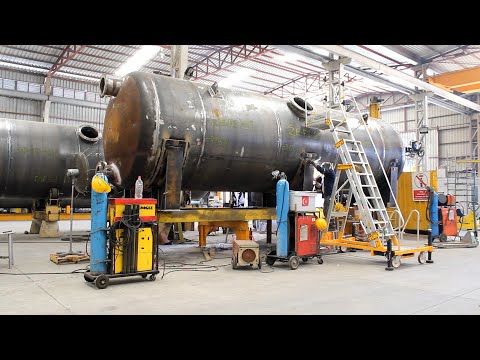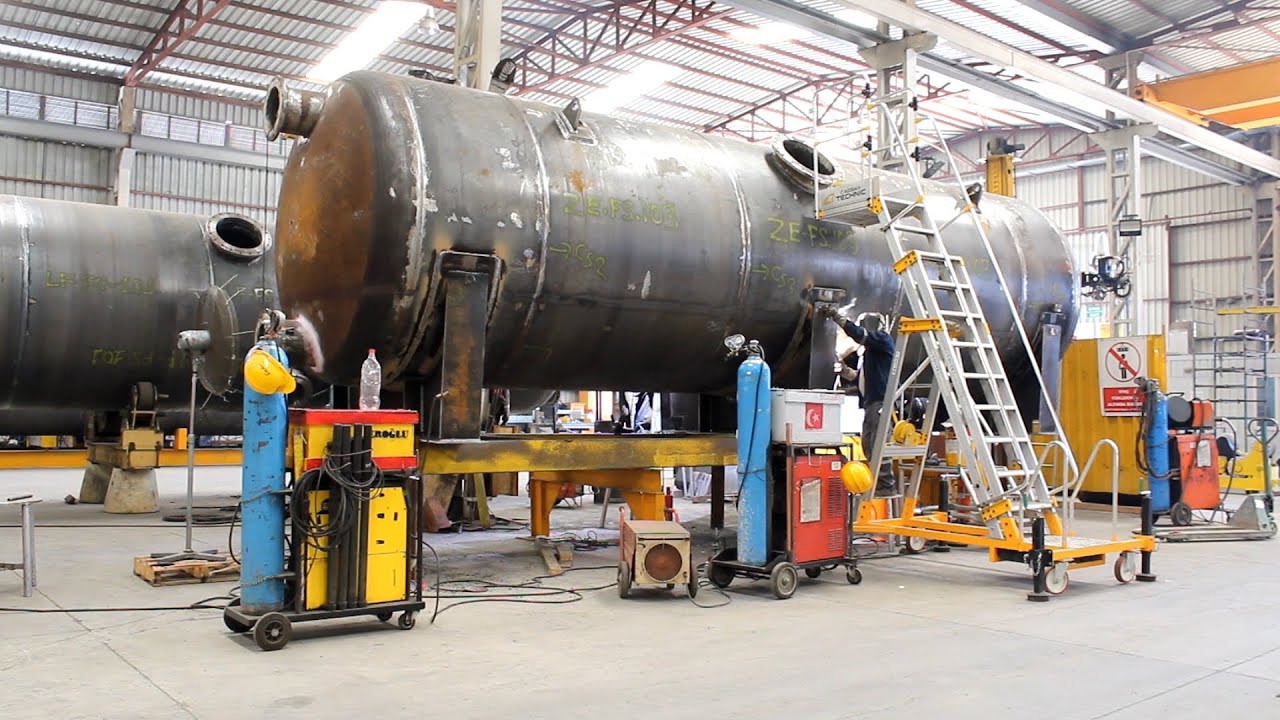Pressure vessel fabrication is an intricate process that combines meticulous engineering and skilled craftsmanship to create robust and reliable containers capable of withstanding immense pressure. With utmost precision and attention to detail, pressure vessels are meticulously constructed using advanced materials and cutting-edge techniques to ensure their durability and safety. These vessels play a vital role in various industries, including oil and gas, chemical, and power generation, where they are used to store and transport volatile substances under extreme conditions. Fabrication experts employ state-of-the-art technologies and adhere to stringent quality standards to deliver pressure vessels that meet or exceed industry regulations. Whether it's designing custom vessels or manufacturing standard models, the process involves careful planning, expert welding, rigorous testing, and meticulous finishing. Pressure vessel fabrication requires a deep understanding of engineering principles, materials science, and regulatory compliance to ensure the highest level of performance and safety. By entrusting your pressure vessel fabrication needs to skilled professionals, you can rest assured that you will receive a top-notch product engineered to withstand the harshest operating conditions.

The Importance of Pressure Vessel Fabrication
Pressure vessels are crucial components in various industries, including oil and gas, chemical, pharmaceutical, and food processing. These vessels are designed to store and transport substances under high pressure, making them subject to immense stress and potential hazards. Therefore, it is essential to ensure that pressure vessels are fabricated with the highest quality standards to guarantee safety, reliability, and efficiency.
The Fabrication Process
Pressure vessel fabrication involves several intricate steps to create a vessel capable of withstanding extreme pressure. The process begins with meticulous design and engineering, where experts analyze the specific requirements, such as pressure limits, temperature ranges, and material compatibility. Once the design is finalized, the fabrication process commences.
Material selection plays a vital role in pressure vessel fabrication. The chosen material must possess high strength, corrosion resistance, and the ability to withstand the intended operating conditions. Common materials used include carbon steel, stainless steel, and various alloys.
Cutting and forming of metal sheets are then performed according to the vessel's design. This involves precise measurements, cutting techniques, and bending or rolling processes to achieve the desired shape and dimensions.
Welding is a critical step in pressure vessel fabrication. Skilled welders utilize various welding techniques, such as shielded metal arc welding (SMAW), gas tungsten arc welding (GTAW), or submerged arc welding (SAW), to join the metal sheets together. The welds must be of high quality to ensure the vessel's structural integrity.
Heat treatment is often necessary to improve the mechanical properties of the vessel. This process involves subjecting the vessel to controlled heating and cooling cycles, which help relieve residual stresses and enhance its strength and toughness.
Quality control measures are implemented throughout the fabrication process to ensure that the vessel meets all required standards. This includes non-destructive testing (NDT) methods, such as ultrasonic testing, radiography, and dye penetrant inspection, to detect any defects or flaws that may compromise the vessel's integrity.
The Importance of Compliance
Pressure vessel fabrication must adhere to stringent industry standards and codes to guarantee safety and reliability. Regulations such as the American Society of Mechanical Engineers (ASME) Boiler and Pressure Vessel Code provide guidelines for the design, fabrication, inspection, and testing of pressure vessels.
Compliance with these codes ensures that pressure vessels are fabricated to withstand the intended operating conditions without posing any risk to personnel, the environment, or surrounding equipment. Non-compliance can result in catastrophic failures, leading to injuries, fatalities, and significant financial losses.
The Role of Certified Fabricators
Selecting a certified pressure vessel fabricator is crucial for ensuring the highest quality standards. Certified fabricators have undergone rigorous evaluations and audits to demonstrate their competence in designing and fabricating pressure vessels.
These fabricators possess the necessary expertise, experience, and knowledge to meet the specific requirements and regulations of the industry. They are equipped with advanced tools, technology, and facilities to carry out fabrication processes with precision and efficiency.
Working with certified fabricators also provides assurance that the pressure vessel will undergo thorough inspections and testing throughout the fabrication process. These fabricators have established quality control procedures and documentation systems to ensure compliance with industry codes and standards.
The Benefits of Quality Pressure Vessel Fabrication
Investing in high-quality pressure vessel fabrication offers several benefits:
Enhanced safety: Proper fabrication techniques and adherence to industry standards minimize the risk of accidents, ensuring the safety of personnel and the surrounding environment.
Reliability and longevity: Quality fabrication techniques and materials result in pressure vessels that can withstand harsh operating conditions and have a longer lifespan.
Reduced maintenance: Well-fabricated pressure vessels require less frequent maintenance and repairs, reducing downtime and associated costs.
Efficiency: Accurate fabrication techniques and optimal material selection improve the efficiency of pressure vessels, resulting in reduced energy consumption and increased productivity.
Compliance: High-quality fabrication ensures compliance with industry codes and regulations, preventing legal and financial repercussions.
Conclusion
Pressure vessel fabrication is a complex process that demands expertise, precision, and adherence to industry standards. The fabrication of these vessels is crucial for ensuring safety, reliability, and efficiency in various industries. By selecting certified fabricators and investing in quality fabrication, businesses can reap the benefits of enhanced safety, longevity, reduced maintenance, improved efficiency, and compliance with industry regulations.
Crafting the Perfect Pressure Vessel: ERGIL's Cutting-Edge Manufacturing Journey
Pressure Vessel Fabrication
Pressure Vessel Fabrication
| Aspect | Description |
|---|---|
| Design Standards | Pressure vessels are fabricated according to internationally recognized codes and standards such as ASME Boiler and Pressure Vessel Code (BPVC), EN 13445, and PD 5500. These standards ensure the vessels' safety, reliability, and compliance with industry requirements. |
| Material Selection | The selection of materials for pressure vessel fabrication is critical to ensure structural integrity and resistance to the process environment. Common materials include carbon steel, stainless steel, and various alloys. Factors like corrosion resistance, strength, and weldability are carefully considered during material selection. |
| Welding Techniques | Welding plays a vital role in pressure vessel fabrication, ensuring leak-tight joints and overall structural integrity. Different welding techniques, such as shielded metal arc welding (SMAW), gas tungsten arc welding (GTAW), and flux-cored arc welding (FCAW), are employed based on material compatibility and specific project requirements. |
| Quality Control | Stringent quality control measures are implemented throughout the fabrication process. Non-destructive testing methods, including radiography, ultrasonic testing, and dye penetrant inspection, are employed to detect any defects or flaws. Thorough inspections and documentation ensure compliance with the applicable codes and standards. |
| Heat Treatment | Heat treatment processes, such as stress relieving and normalization, are often employed to enhance the mechanical properties and relieve residual stresses in the pressure vessel. These processes ensure the vessel's durability and longevity under high-pressure operating conditions. |
| Pressure Testing | Before being commissioned, pressure vessels undergo rigorous hydrostatic or pneumatic testing to validate their strength and leak-tightness. This involves subjecting the vessel to pressures higher than its operating design pressure to ensure it can safely withstand the intended service conditions. |
| Documentation and Certification | Thorough documentation of the fabrication process, including material traceability, welding procedures, inspection reports, and test certificates, is crucial. These records provide evidence of compliance with the applicable standards and facilitate future maintenance, repairs, and regulatory audits. |
As experts in pressure vessel fabrication, we prioritize safety, quality, and compliance with industry standards. Our extensive knowledge and experience in design, material selection, welding techniques, and quality control enable us to deliver reliable and high-performance pressure vessels. By employing heat treatment processes and conducting thorough pressure testing, we ensure the longevity and integrity of our vessels. Our commitment to meticulous documentation and certification guarantees transparency and traceability throughout the fabrication process. Trust us for your pressure vessel needs, and we will exceed your expectations.

